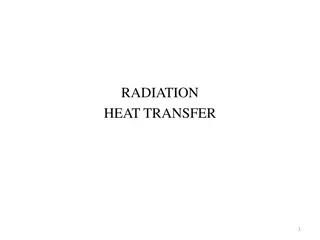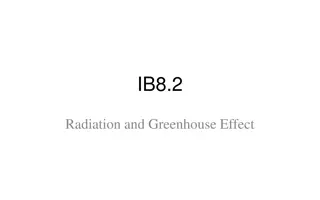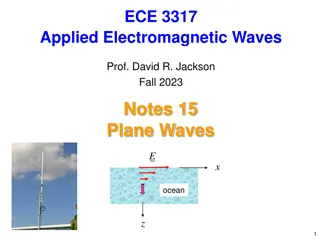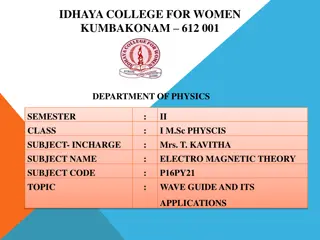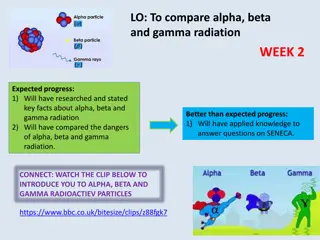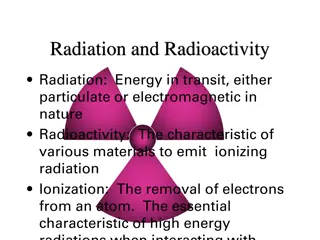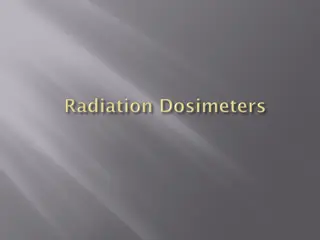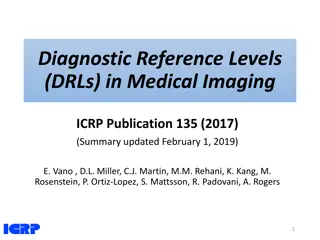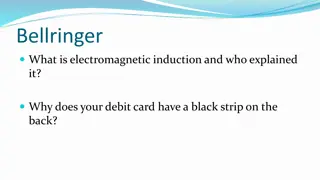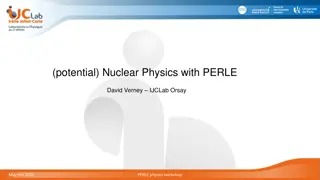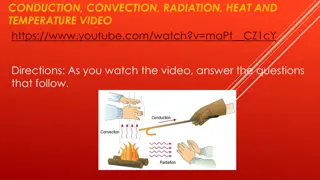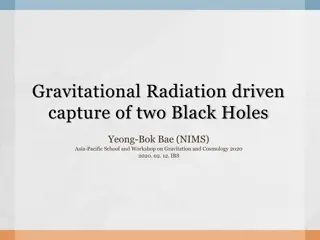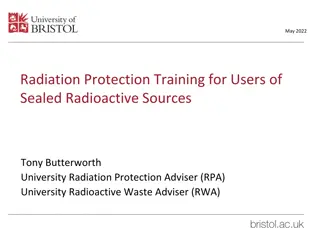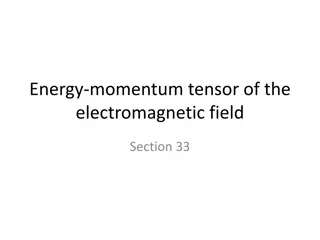Understanding Electromagnetic Radiation and its Properties
This educational content delves into the arrangement of electrons in atoms, focusing on the properties of light and the electromagnetic spectrum, including the visible light spectrum. It explains wavelike behavior, wavelength, frequency, and their mathematical relationship, providing practice questions for better comprehension. Dive into the world of electromagnetic radiation with this detailed resource.
- Electromagnetic radiation
- Properties of light
- Wavelike behavior
- Frequency and wavelength
- Atomic structure
Download Presentation

Please find below an Image/Link to download the presentation.
The content on the website is provided AS IS for your information and personal use only. It may not be sold, licensed, or shared on other websites without obtaining consent from the author. Download presentation by click this link. If you encounter any issues during the download, it is possible that the publisher has removed the file from their server.
E N D
Presentation Transcript
UNIT 4 Arrangement of Electrons in Atoms
PROPERTIES OF LIGHT The wave description of light Electromagnetic radiation a form of energy that exhibits wavelike behavior as it travels through space. Wavelike behavior what does this include?? Reflection Refraction Interference Together, all forms of electromagnetic radiation form the electromagnetic spectrum.
THE ELECTROMAGNETIC SPECTRUM https://www.youtube.com/watch?v=kOkv8ynpppk
Wavelike behavior = repetitive nature Wavelength ( )- distance between equivalent points on a continuous wave Expressed in m or nm. Frequency(s-1 or Hertz, Hz) the number of waves that pass a given point in a specific time. Shorter Wavelength = higher frequency Longer wavelength = lower frequency
FREQUENCY AND WAVELENGTH Mathematically related to each other. c = c = speed of light (2.998 108 m/s) (constant) = wavelength in meters (m) = frequency in s-1 or Hz
PRACTICE 1. What is the wavelength of green light, which has a wavelength of 8.16x1014 Hz? 2. An X-ray has a wavelength of 1.15x10-10 mm. What is its frequency?
RECALL 3. What is the wavelength of an electromagnetic wave that has a frequency of 78x106 Hz? 4. A popular radio station broadcasts with a frequency of 94.7 MHz. What is the wavelength of the broadcast? (1 MHz = 106 Hz)
WHITE BOARDING PRACTICE 1. What is the wavelength of a wave having a frequency of 3.76 x 1014 s-1? 2. What is the frequency of a 6.9 x 10-13 m wave? 3. What is the wavelength of a 1.28 x 1017 Hz wave? 4. What is the frequency of a 2,600 cm wave? 5. What is the wavelength of a 4.34 x 1015 /s wave? 6. What is the frequency of a 5.6 x 1010 m wave? 7. What is the wavelength of 109.6 MHz wave (1 MHz = 1x106 Hz)? 8. What is the relationship between wavelength and frequency?
NUCLEAR ATOM AND UNANSWERED QUESTIONS Rutherford s nuclear model of the atom was not complete: Distribution of electrons? What prevented attraction between nucleus and electrons?
THE PHOTOELECTRIC EFFECT In the early 1900s, scientists studied experiments that could not be explained by the wave theory of light. The photoelectric effect The emission of electrons from a metal when light shines on the metal. Light must be at a minimum frequency to knock an electron loose from the metal If light was wavelike only, any frequency of light would cause a loss of an electron.
MAX PLANCK Studied emission of light by hot objects. Proposed that hot objects do not emit electromagnetic energy continuously, but in small, specific packets called quanta. A quantum is the minimum quantity of energy that can be lost or gained by an atom. E = h Where E is energy in Joules (J) of a quantum of radiation h = Planck s constant = 6.626 x 10-34 J s (Joule x second) = frequency (s-1)
DUAL WAVE-PARTICLE NATURE OF LIGHT Light exhibits both wave and particle-like behavior Each particle carries a quantum of energy A photon is a particle of electromagnetic radiation having zero mass and carrying a quantum of energy. Ephoton = hv
CALCULATING THE ENERGY OF A PHOTON What is the energy of a wave with the frequency of 6.32x1020 s-1 A wave carries 6.82x10-10 J of energy, what is the frequency of the wave?
HONORS PRACTICE How many Joules of energy are contained in a photon with a wavelength of 550 nm? The energy of a particular color of green light is 3.82 x 10-22 kJ. What is its wavelength in nanometers?
WHITE BOARDING A laser emits light of frequency 4.74 x 1014 s-1. What is the energy of the light? In kJ? A certain electromagnetic wave has a wavelength of 625 nm. What is the energy of the wave?
BELL RINGER What is the wavelength of radiation whose frequency is 1.50x1013 Hz. A certain electromagnetic wave has a wavelength of 5.50x10-2 m. What is the energy of the wave?
ATOM EMISSIONS Ground state the lowest energy state of an atom Excited state A state in which an atom has a higher potential energy than it has in its ground state Different jumps of energy provide different frequencies of emission and therefore, produce different colors. Photon Photon
LINE SPECTRA A continuous spectrum all frequencies of light can be observed A prism can separate light into isolated colors. These separate colors are known as the line emission spectrum of that particular element. Represents the spectrum of frequencies of EM radiation emitted.
THE HYDROGEN LINE EMISSION SPECTRA Three series Lyman Emission occurs in the ultraviolet region Balmer Visible light region Paschen Occurs in infrared region
Wave theorypredicted H to have a continuous spectrum. Quantum theory was developed to explain the line emission spectra of H. Since H only emitted specific frequencies of light, the energy differences between energy states must be fixed as well. Provided the idea for the Bohr model of the atom.
BOHR MODEL OF HYDROGEN ATOM Niels Bohr model of the atom Electrons can only circle nucleus in paths or orbits (like planets around the sun) Each orbit level has a fixed amount of potential energy. Electrons have higher energy the further away from the nucleus they are. E3 E3 E2 E2 E1 E1 https://www. youtube.co m/watch?v= GhAn8xZQ- d8 Absorption Emission
ONE PROBLEM Bohr s model only worked for Hydrogen, a single electron atom. It did not apply to atoms with more than one electron. Did not explain the chemical behavior of atoms
BELL RINGER A laser emits light of frequency 8.5 x 1012 s-1. What is the energy of the light? In kJ? A certain electromagnetic wave has a wavelength of 713 pm. What is the energy of the wave? A wave has a wavelength of 5.98x10-5 m, what is its frequency?
SECTION 2 The Quantum Model of an Atom
ELECTRONS AS WAVES 1924 Louis de Broglie proposed that electrons also carried dual wave-particle nature. Suggested that electrons behaved as waves in that they could only exist at specific frequencies. These frequencies corresponded to the quantized energies of Bohr s orbits. HOW? Combined Planck s E = hc/ and E = mc2 Suggested that anything with mass and velocity has a wavelength. Therefore, electrons behave as waves also.
HEISENBURG UNCERTAINTY PRINCIPLE If electrons behave as both particles and waves, where are they in the atom?? Heisenburg Uncertainty Principle it is impossible to determine simultaneously both the position and velocity of an electron or any other particle. Therefore, orbitals exist - a 3D region around the nucleus that indicates the probable location of an electron.
ATOMIC ORBITALS AND QUANTUM NUMBERS Quantum numbers specify the properties of atomic orbitals and the properties of electrons in orbitals Four numbers: Principle quantum number main energy level Angular momentum shape or orbital Magnetic orientation of orbital Spin of electron fundamental spin state of electron https://www.youtube.com/watch?v=Aoi4j8es4gQ
SECTION 3 Electron Configurations
ELECTRON CONFIGURATIONS What are they?? The arrangement of electrons in an atom All electrons want to be in as low of an energy state as possible (ground-state electron config). Simple rules allow us to easily determine the electron configurations of atoms
RULES GOVERNING ELECTRON CONFIGS Aufbau principle an electron occupies the lowest energy orbital that can receive it. Pauli exclusion principle no two electrons in the same atom can have the same set of four quantum numbers. Hund s rule orbitals of equal energy are each occupied by one electron before any orbital is occupied by a second electron, and all electrons in singly occupied orbitals must bear the same spin state.
REPRESENTING ELECTRON CONFIGS Three ways Orbital Notation Uses arrows for electrons to show spin states. Electron-configuration notation number of electrons in a sublevel is shown as a superscript Noble gas notation symbol for noble gas is enclosed in brackets
ORBITAL DIAGRAM PRACTICE Draw the orbital diagram for fluorine. Draw the orbital diagram for bromine.
ELECTRON CONFIGURATION PRACTICE Write the electron configuration for nickel. Write the electron configuration for lead.
NOBLE GAS NOTATION PRACTICE Write the noble gas notation for gold. Write the noble gas notation for Dyprosium (Dy).
BELL RINGER Draw the orbital diagram for Chromium Write the electron configuration for Barium Write the noble gas configuration for Tin









